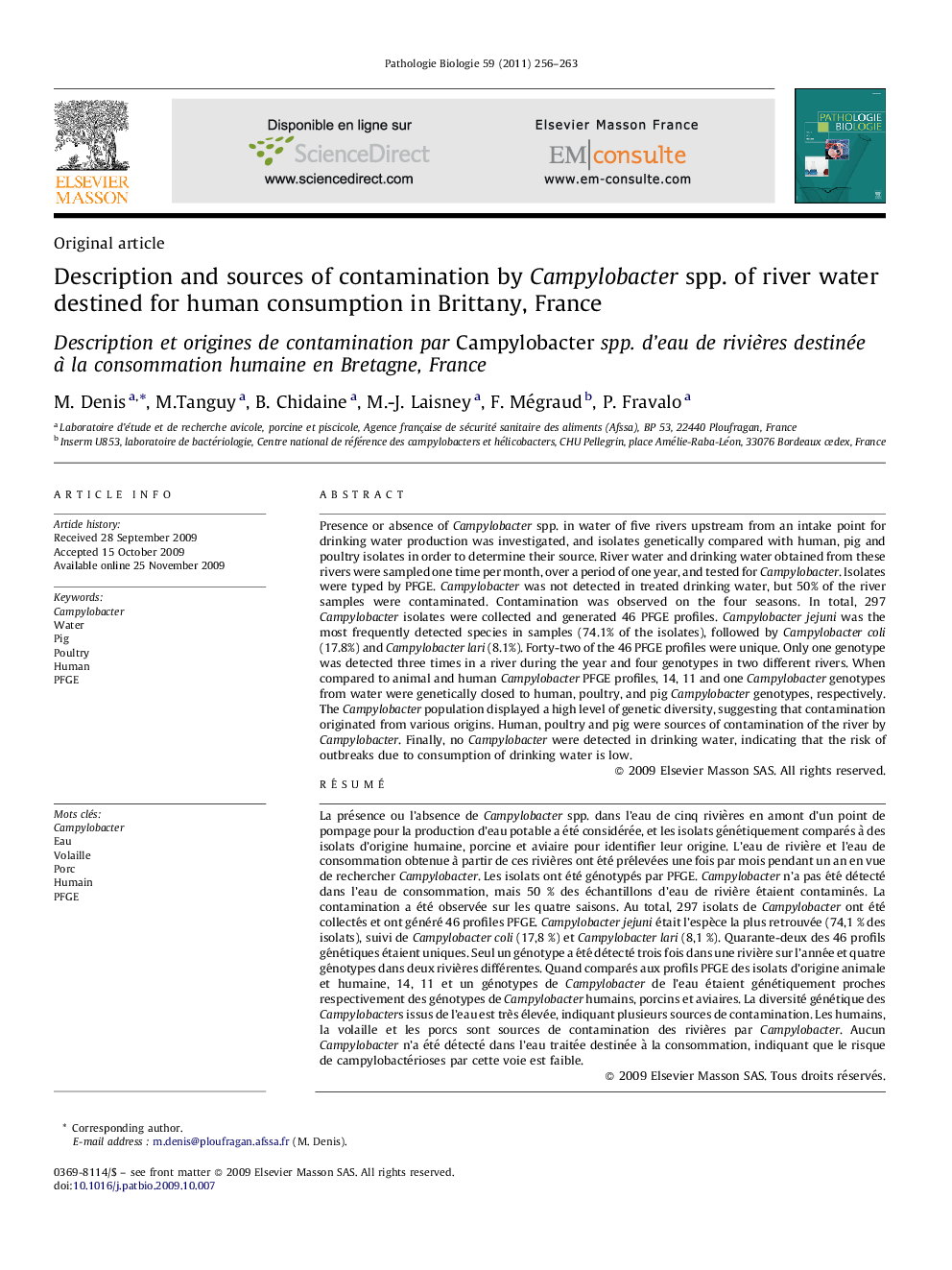| کد مقاله | کد نشریه | سال انتشار | مقاله انگلیسی | نسخه تمام متن |
|---|---|---|---|---|
| 4136243 | 1271904 | 2011 | 8 صفحه PDF | دانلود رایگان |

Presence or absence of Campylobacter spp. in water of five rivers upstream from an intake point for drinking water production was investigated, and isolates genetically compared with human, pig and poultry isolates in order to determine their source. River water and drinking water obtained from these rivers were sampled one time per month, over a period of one year, and tested for Campylobacter. Isolates were typed by PFGE. Campylobacter was not detected in treated drinking water, but 50% of the river samples were contaminated. Contamination was observed on the four seasons. In total, 297 Campylobacter isolates were collected and generated 46 PFGE profiles. Campylobacter jejuni was the most frequently detected species in samples (74.1% of the isolates), followed by Campylobacter coli (17.8%) and Campylobacter lari (8.1%). Forty-two of the 46 PFGE profiles were unique. Only one genotype was detected three times in a river during the year and four genotypes in two different rivers. When compared to animal and human Campylobacter PFGE profiles, 14, 11 and one Campylobacter genotypes from water were genetically closed to human, poultry, and pig Campylobacter genotypes, respectively. The Campylobacter population displayed a high level of genetic diversity, suggesting that contamination originated from various origins. Human, poultry and pig were sources of contamination of the river by Campylobacter. Finally, no Campylobacter were detected in drinking water, indicating that the risk of outbreaks due to consumption of drinking water is low.
RésuméLa présence ou l’absence de Campylobacter spp. dans l’eau de cinq rivières en amont d’un point de pompage pour la production d’eau potable a été considérée, et les isolats génétiquement comparés à des isolats d’origine humaine, porcine et aviaire pour identifier leur origine. L’eau de rivière et l’eau de consommation obtenue à partir de ces rivières ont été prélevées une fois par mois pendant un an en vue de rechercher Campylobacter. Les isolats ont été génotypés par PFGE. Campylobacter n’a pas été détecté dans l’eau de consommation, mais 50 % des échantillons d’eau de rivière étaient contaminés. La contamination a été observée sur les quatre saisons. Au total, 297 isolats de Campylobacter ont été collectés et ont généré 46 profiles PFGE. Campylobacter jejuni était l’espèce la plus retrouvée (74,1 % des isolats), suivi de Campylobacter coli (17,8 %) et Campylobacter lari (8,1 %). Quarante-deux des 46 profils génétiques étaient uniques. Seul un génotype a été détecté trois fois dans une rivière sur l’année et quatre génotypes dans deux rivières différentes. Quand comparés aux profils PFGE des isolats d’origine animale et humaine, 14, 11 et un génotypes de Campylobacter de l’eau étaient génétiquement proches respectivement des génotypes de Campylobacter humains, porcins et aviaires. La diversité génétique des Campylobacters issus de l’eau est très élevée, indiquant plusieurs sources de contamination. Les humains, la volaille et les porcs sont sources de contamination des rivières par Campylobacter. Aucun Campylobacter n’a été détecté dans l’eau traitée destinée à la consommation, indiquant que le risque de campylobactérioses par cette voie est faible.
Journal: Pathologie Biologie - Volume 59, Issue 5, October 2011, Pages 256–263